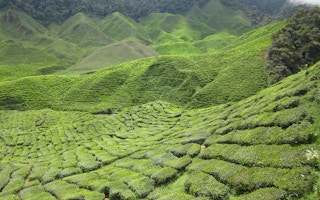The Cameron Highlands have long been regarded as a lush, green escape from Malaysia’s tropical heat, but agricultural overdevelopment and tourism have decimated natural landscapes and created problems that could make it dangerous for locals and unappealing for tourists to visit in the future.
To continue reading, subscribe to Eco‑Business.
There's something for everyone. We offer a range of subscription plans.
- Access our stories and receive our Insights Weekly newsletter with the free EB Member plan.
- Unlock unlimited access to our content and archive with EB Circle.
- Publish your content with EB Premium.
Due to its elevation of 1800 meters, the Cameron Highlands have proved to be a lucrative area for agriculture and tourism, with hostels, hotels, restaurants and pop-up tour offices crowding the main town of Tanah Rata.
Most of the tourism in the region is agritourism which focuses on trips to tea and strawberry plantations, and honey farms. As a result, tea plantations, strawberry fields and other agricultural sites have proliferated in the area in recent years. This has led to massive overdevelopment in the region as locals try to get a piece of the profitable tourism industry for themselves. Unfortunately, this development has been at the expense of highland forests, putting the region at a high risk for landslides and soil erosion.
An ecosystem disturbed
Landslides have become a common occurrence. As recently as May 17th this year—three days before I visited! —there was a flash flood that displaced 32 people and affected other properties and businesses. Land clearing for agriculture—both legal and illegal—is largely to blame for this problem.
Clearing land is very problematic for two reasons. Firstly, the removal of trees and their root systems loosens soil. Paired with a large amount of rainfall this can lead to landslides. Secondly, removing forests drastically raises temperatures. This has the potential to undermine one of the Cameron Highland’s key selling points: it is cooler than the rest of the country.
In an undisturbed ecosystem, water is absorbed by soil and vegetation. If it is not absorbed then water pools naturally in catchment areas and the run off flows into rivers, creeks, lakes or the ocean. However, land clearing and the subsequent development of hill slopes, urbanization, and other human land uses have led to changes in the water cycle in the Cameron Highlands.
By covering the top layer of soil with concrete or asphalt, the water is unable to penetrate the ground or become absorbed by vegetation. Instead it gathers more quickly and then floods. This moves the top soil more rapidly, and results in a landslide.
Lack of planning scares tourist dollars
The regional tourism has more to be concerned with than landslides, however. The Cameron Highland’s idyllic beauty is marred with the unplanned sprawl of its main tourist hub, Tanah Ratah. While the area’s abundance of accommodation, restaurants, tour operators and agricultural tourism bring significant income into the region, the resulting air pollution, traffic congestion, and clearing of land make it notably less appealing for visitors.
Among these issues, however, it is land clearing that has proven itself to be most immediately harmful. Locals have been driven from their homes by hotel development. It is development aimed at supplying tourism that is prioritized in this popular tourist area, not local housing.
With fewer available housing options many locals choose to clear land illegally on slopes, some of which are at a higher risk for landslides. This irresponsible prioritization of the financial gains offered by tourism over the housing and land needs of locals has been a major factor in the geological destabilization of the area.
Unfortunately for those whose livelihoods depend on the tourism dollars brought in by the Cameron Highlands, overdevelopment for the sake of tourism has frightened many of those intended tourists away. Potential landslides are not a top priority for many tourists planning their vacations.
Indeed, with every landslide tourists have been scared from the region. Without more extensive long-term planning of tourism development, the Cameron Highlands run the risk of becoming an avoided and overrun landscape, no longer the famed home of the mossy forest and idyllic natural beauty.
“
Potential landslides are not a top priority for many tourists planning their vacations.
Two steps forward, one step back
Authorities are trying to address these issues, but the effectiveness of their efforts is questionable. In 2016, for instance, the local government released their development plans for the county. Their stated goal was to restore the “Glory of Cameron Highlands as a prime highland tourist destination by emphasizing on rehabilitation, preservation and enhancement of the surroundings through good developmental practices” by 2030.
However, a local NGO called Regional Environmental Awareness Cameron Highlands (REACH) evaluated these plans and found that it was quite the opposite. REACH said that the plans include defacing one side of a mountain to build an aerial tramway to relieve traffic congestion, and even possibly building a road on a water catchment area. Instead of helping the situation, these plans will decimate some of the most biologically diverse areas in the highlands.
To further complicate the situation, the region is plagued by a multi-tiered bureaucracy that facilitates the sale of land to large corporations while giving the impression of regulation. Unfortunately, despite strong promises to regulate land use, frequently there is little enforcement. Indeed, many members of the community have accused all levels of government involved in these issues of corruption.
Despite the bleak outlook, some steps have slowly been taken by the federal government to curb overdevelopment. The Forestry Department of Peninsular Malaysia has created the Cameron Highlands Mountain Park, and has funded scientific expeditions into the region and is working with local authorities to reduce illegal land clearing .
However, the enforcement of these regulation efforts is rather uneven, focusing primarily on small-scale farmers instead of those illegally farming on large tracts of land.
Despite these challenges, NGOs like REACH are working to raise awareness for rainforest conservation as well as environmentally friendly agricultural practices. They also fund conservation and water quality research using grants received from the forestry department and have completed rehabilitation of illegally cleared land.
Additionally, scientists are creating models and programs that could be used to accurately identify areas that are at a high-risk for landslides so that development does not occur there. Though this research doesn’t address the root cause of the problem, it’s necessary to have scientifically accurate information to avoid development on unstable land.
Overall, the collective work done by scientists and R.E.A.C.H is desperately needed for the overdeveloped region and will hopefully preserve what is left of the Cameron Highlands for future generations. For real improvements to occur, however, the federal and local state governments need to regulate regional development. Furthermore, they need to introduce stricter fines for clearing land illegally.
Lastly, they should create a program that incentivizes sustainable agricultural practices so that soil erosion is reduced and landslides and flash flood disasters decline in frequency.
Ranah Chavoshi is a Canadian Biologist . This article was written exclusively for Eco-Business.











